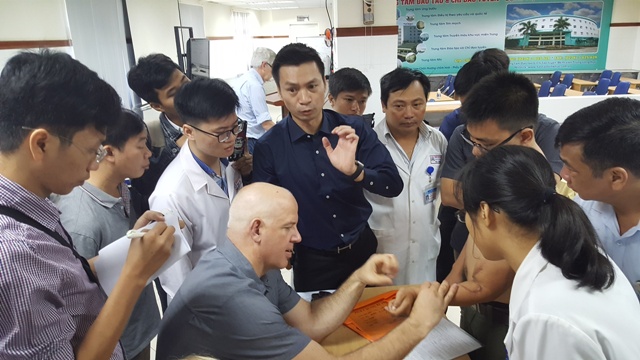
Tuesday, 23/10/2018 16:53
(GMT+7)
Transfer of technology for hand malformation surgery
TTH.VN - From 22nd to 26th of October, an international team of experts from Australia coordinated with the Hue Central Hospital to hold a training course on transferring new technology of hand malformation surgery for 80 doctors of Orthopedics and Pediatrics of the hospitals in the Central region and throughout the country.
This is the 15th training course, with the subject of "Micro Surgery and Hand Surgery" updated by specialists from hospitals in Australia and the UK in a special method: lecturing going along with practical exercises on the tissues that all trainees were practicing on, and with clinical and surgical abutments, so that after the course, trainees could perform well on the cases they had approached exactly.
On this occasion, specialists and practitioners conducted screening and diagnosis of 80 cases of hand defects; in which about 40 cases related to hand deformities and brachial plexus injury at Hue Central Hospital. In each case of surgery, Australian professionals and practitioners have the opportunity to exchange, share professional experiences, update new surgical methods for congenital finger malformations, finger deformity surgery, dysplasia of the hands ...

Experts and practitioners screen for hand deformities before surgery
According to Dr. Ho Man Truong Phu, Deputy Director of the Orthopedics Traumatology-Plastic Surgery-Burn Center, Hue Central Hospital, hand deformity is one of the most common congenital defects in Vietnam, and it greatly affects the motor function as well as the psychological development of human. The timely and correct detection and surgery will help children overcome the deformities and integrate well in the community.
.jpg)
Doctors register for the course
Assoc. Prof. Dr. Nguyen Duy Thang, Deputy Director of Hue Central Hospital, said that since 1996, there has been an Australian team led by Dr. Scougali to cooperate with Hue Central Hospital to hold the training courses. These courses are designed for those specialists to share skills and experience in the field of hand surgery for doctors in Vietnam. These are useful and effective training courses, especially in the examination and performing orthopedic surgeries for patients.
News, photos: Minh Van